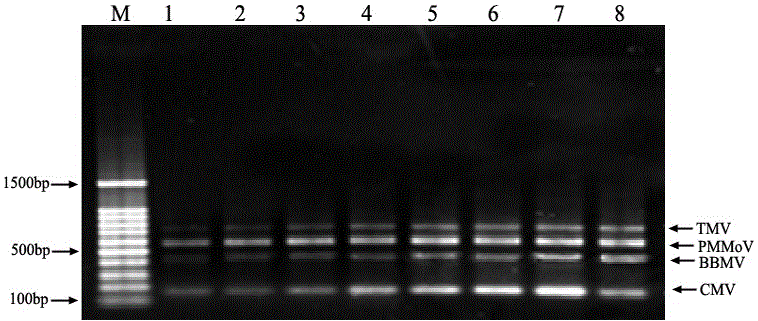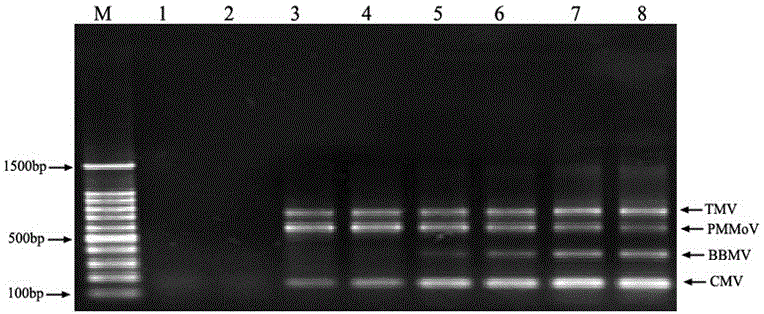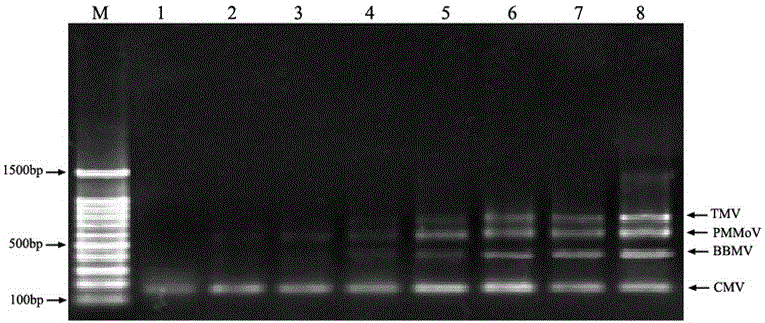Multiple RT-PCR method for fast detecting four kinds of pepper viruses
An RT-PCR, pepper technology, applied in the directions of microorganism-based methods, biochemical equipment and methods, and the determination/inspection of microorganisms, can solve problems such as reports of multiple RT-PCR detection methods that have not yet been seen, and achieve rapid and accurate detection. The effect of testing requirements, reducing the number of operations, and easy operation
- Summary
- Abstract
- Description
- Claims
- Application Information
AI Technical Summary
Problems solved by technology
Method used
Image
Examples
Embodiment 1
[0051] Example 1. Design and synthesis of primers
[0052] According to the conserved fragments of the coat protein (CP) gene sequence of CMV, PMMoV, and TMV isolates reported in the literature and GenBank and the conserved fragment of the nucleotide sequence of the non-coding region of the BBWV 5' end part of the genome, Primer5.0 primer design software was used The specific primers for these 4 viruses were designed respectively. Since multiplex PCR requires simultaneous amplification of multiple target fragments at the same annealing temperature, soft DNAMAN is used to calculate the Tm value of the primers, screen a large number of designed primers, and select primers with relatively consistent Tm values to ensure that the primers in the same annealing temperature Four pathogens, CMV, PMMoV, BBWV and TMV, were detected at the same temperature. The detailed virus-specific primer sequences are shown in Table 1, and all primers were synthesized by Shanghai Sangon Bioengineer...
Embodiment 2
[0055] Embodiment 2. The establishment of multiple RT-PCR reaction system
[0056] 1. Extraction of plant total RNA
[0057] About 0.1 μg of fresh or frozen pepper samples to be tested were ground into powder in liquid nitrogen, and the total RNA of the samples was extracted using a plant total RNA extraction kit. Extract RNA product and add DEPC-ddH 2 dissolved in O and stored at -70°C for later use.
[0058] 2. Synthesis of cDNA
[0059] Using the extracted total RNA of the pepper sample to be tested as a template, the cDNA template was prepared by reverse transcription. The reverse transcription system is 20 μL including: RNA template 2 μL, 2.5 mmol / L dNTPs 2 μL, 10 μmol / L random primer 2 μL, 10×RTmix 2 μL, QuantReverseTranscriptase 2 μL, RNase-freeddH 2 O10 μL. Reaction conditions: 37°C, 60min.
[0060] 3. Establish and optimize the multiplex RT-PCR reaction system and reaction procedures
[0061] (1) Hybrid template
[0062] Use the recombinant plasmids PGM-CMV, P...
Embodiment 3
[0080] Example 3. Sensitivity detection of multiple RT-PCR reactions
[0081] In order to determine the detection sensitivity of multiplex RT-PCR, the total RNA (90?ng / μL) of plants co-infected by four viruses containing CMV, PMMoV, BBWV and TMV was diluted to 10 1 ~10 7 Six gradients to obtain dilutions with concentrations of 9.0ng / μL, 0.9ng / μL, 90pg / μL, 9.0pg / μL, 0.9pg / μL, 90fg / μL, and 9fg / μL, and use the dilutions as templates According to the reaction system and procedure in Step 2 of Example 2, cDNA was obtained by reverse transcription, and multiple PCR reactions were performed according to the optimal reaction system and the optimal reaction procedure.
[0082] Take 5?μL of PCR products and electrophoresis in agarose 1×TAE buffer system with a concentration of 15?g / L. After EB staining, use a gel imaging system to observe and record the results with photography.
[0083] The experimental results are attached Image 6 As indicated, the RNA of the four virus co-infecti...
PUM
 Login to View More
Login to View More Abstract
Description
Claims
Application Information
 Login to View More
Login to View More - R&D
- Intellectual Property
- Life Sciences
- Materials
- Tech Scout
- Unparalleled Data Quality
- Higher Quality Content
- 60% Fewer Hallucinations
Browse by: Latest US Patents, China's latest patents, Technical Efficacy Thesaurus, Application Domain, Technology Topic, Popular Technical Reports.
© 2025 PatSnap. All rights reserved.Legal|Privacy policy|Modern Slavery Act Transparency Statement|Sitemap|About US| Contact US: help@patsnap.com



